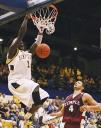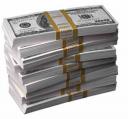Today is the beginning of that annual rite of spring known as March Madness. People pick the winners of the 65-team, three-week tournament that is the second biggest sports event in the United States.
 The most endearing aspect about the tournament is anyone can do it. Some people pick their alma mater. I’d love to choose Haminn Quiantance and my Golden Flashes, but UNLV is a tough matchup, and they surely won’t beat Kansas if they win round one. Some people pick the most fearsome mascots. Some people tend to flock to the favorite. Count me among that group – I think North Carolina has the best team and best player overall, so that’s my pick. I’ll make sure to rub it in if I’m right in three weeks.
The most endearing aspect about the tournament is anyone can do it. Some people pick their alma mater. I’d love to choose Haminn Quiantance and my Golden Flashes, but UNLV is a tough matchup, and they surely won’t beat Kansas if they win round one. Some people pick the most fearsome mascots. Some people tend to flock to the favorite. Count me among that group – I think North Carolina has the best team and best player overall, so that’s my pick. I’ll make sure to rub it in if I’m right in three weeks.
Clearly, I’m not alone in picking. This year, 37 million people are expected to gamble on this year’s tournament, according to Challenger, Gray & Christmas, a job counseling firm in Chicago. Some estimate that as much as $2.5 billion will be wagered this year alone.
In general, I don’t mind this wagering. Spherion Corp. estimates that 75% of the people betting don’t wager more than $20 on the tournament. What’s wrong with some low stakes fun?
The NCAA can find lots of things wrong with it. Especially from a public relations standpoint. In fact, there is a very checkered history of NCAA basketball point-shaving and gambling scandals. These scandals have long been the biggest public relations problem for an institution that is supposed to be about student athletes, not an over-under gambling line.
The gambling issues go as far back as 1951, when the Kentucky Wildcats and six other teams combined to fix 86 games. The scandals continued to get worst until the late 1980s and early 1990s. Future NBA stars from Tulane and Arizona State fixed games for money. Rumors of hookers, pay-for-play and gambling involvement followed former UNLV coach Jerry Tarkanian for years.
These situations would be the definition of a public relations crisis. So what did the NCAA do? It cracked down in the early ’90s, sanctioning every team that was found to have violations. The NCAA removed scholarships, suspended coaches, and effectively destroyed some programs like the aforementioned Arizona State and Tulane. I feel like the NCAA did the best it could given the circumstances.
The NCAA has even come down hard on other sports who bet on the tournament. University of Washington football coach Rick Neuheisel was fired in 2003 after he bet in a small scale tournament bracket pool. (He eventually sued and won $4.5 million in salary from the school and NCAA.) As wrong as the firing turned out to be, it did send a message that any gambling, even on a smaller level, is not okay.
The NCAA’s newest public relations problem is today’s general acceptance of gambling. There is also the ever-present possibility that the bookies will be able to poison another squad into point-shaving. For now, the best the NCAA can do is pay close attention. And maybe hope for another March filled with amazing game-winning shots and huge upsets that bust everyone’s bracket.
 Just as long as no one actually puts any money on those brackets, of course.
Just as long as no one actually puts any money on those brackets, of course.



 Posted by markmazz
Posted by markmazz